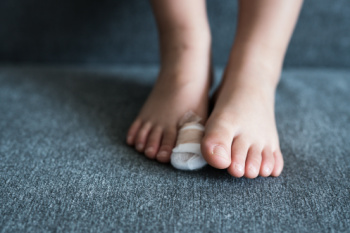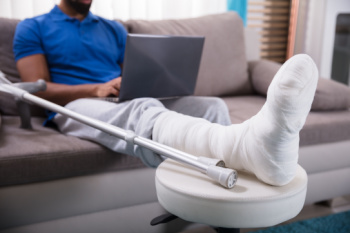Items filtered by date: September 2024
Syndesmosis Injury and Ankle Pain

A syndesmosis injury involves the ligament connecting the tibia and fibula, which are the two main bones of the lower leg just above the ankle. This ligament plays a key role in maintaining stability in the ankle joint. Damage often happens when the foot twists outward in relation to the leg, commonly known as an external rotation injury. Syndesmosis injuries typically occur at the same time as ankle sprains or fractures. Symptoms include pain above the ankle, calf pain, and difficulty bearing weight. Proper diagnosis might involve X-rays or advanced imaging techniques to assess the stability of the joint. Severe cases may require surgery to realign and stabilize the joint. A podiatrist can provide both diagnostic clarity and treatment options, from conservative care to surgical intervention. If you have ankle pain related to the ligaments in your lower leg, it is suggested that you make an appointment with a podiatrist for an exam, diagnosis, and treatment options.
Ankle pain can be caused by a number of problems and may be potentially serious. If you have ankle pain, consult with one of our podiatrists from New York, NY. Our doctors will assess your condition and provide you with quality foot and ankle treatment.
Ankle pain is any condition that causes pain in the ankle. Due to the fact that the ankle consists of tendons, muscles, bones, and ligaments, ankle pain can come from a number of different conditions.
Causes
The most common causes of ankle pain include:
- Types of arthritis (rheumatoid, osteoarthritis, and gout)
- Ankle sprains
- Broken ankles
- Achilles tendonitis
- Achilles tendon rupture
- Stress fractures
- Bursitis
- Tarsal tunnel syndrome
- Plantar fasciitis
Symptoms
Symptoms of ankle injury vary based upon the condition. Pain may include general pain and discomfort, swelling, aching, redness, bruising, burning or stabbing sensations, and/or loss of sensation.
Diagnosis
Due to the wide variety of potential causes of ankle pain, podiatrists will utilize a number of different methods to properly diagnose ankle pain. This can include asking for personal and family medical histories and of any recent injuries. Further diagnosis may include sensation tests, a physical examination, and potentially x-rays or other imaging tests.
Treatment
Just as the range of causes varies widely, so do treatments. Some more common treatments are rest, ice packs, keeping pressure off the foot, orthotics and braces, medication for inflammation and pain, and surgery.
If you have any questions please feel free to contact our office located in New York, NY . We offer the newest diagnostic tools and technology to treat your foot and ankle needs.
Caring for a Broken Toe

Toe fractures, or broken toes, are common injuries that occur when a bone in the toe is cracked or broken, often due to stubbing, dropping something heavy on the foot, or excessive stress during activities. Symptoms include pain, swelling, bruising, and difficulty walking or bearing weight on the affected foot. Left untreated, a fractured toe can lead to complications such as chronic pain, arthritis, or deformities that affect foot function. Immediate action, such as rest, can help reduce swelling and pain, and in some cases, buddy-taping the injured toe to the adjacent one for support is effective. If you have a particularly painful or severe toe fracture, it is suggested that you visit a podiatrist as it may require splinting or possibly surgery.
A broken toe can be very painful and lead to complications if not properly fixed. If you have any concerns about your feet, contact one of our podiatrists from New York, NY. Our doctors will treat your foot and ankle needs.
What to Know About a Broken Toe
Although most people try to avoid foot trauma such as banging, stubbing, or dropping heavy objects on their feet, the unfortunate fact is that it is a common occurrence. Given the fact that toes are positioned in front of the feet, they typically sustain the brunt of such trauma. When trauma occurs to a toe, the result can be a painful break (fracture).
Symptoms of a Broken Toe
- Throbbing pain
- Swelling
- Bruising on the skin and toenail
- The inability to move the toe
- Toe appears crooked or disfigured
- Tingling or numbness in the toe
Generally, it is best to stay off of the injured toe with the affected foot elevated.
Severe toe fractures may be treated with a splint, cast, and in some cases, minor surgery. Due to its position and the pressure it endures with daily activity, future complications can occur if the big toe is not properly treated.
If you have any questions, please feel free to contact our office located in New York, NY . We offer the newest diagnostic and treatment technologies for all your foot care needs.
Pickleball Ankle Injuries and Prevention Techniques

Pickleball, with its fast-paced and dynamic movements, often leads to ankle injuries, such as sprains and strains. Ankle sprains typically occur from sudden twists or missteps, while strains result from overstretching or overuse. To prevent these injuries, players should focus on proper warm-ups and stretching exercises to prepare the muscles and ligaments for activity. Supportive footwear designed for court sports can provide better stability and cushioning, reducing the risk of ankle twists. Additionally, incorporating strengthening exercises for the ankles and improving balance can help support joint stability. Practicing good footwork and being mindful of movement patterns also play a critical role in preventing injuries. If you have endured a foot or ankle injury from playing pickleball, it is suggested that you visit a podiatrist who can offer effective treatment solutions and guide you toward injury prevention techniques.
Ankle and foot injuries are common among athletes and in many sports. They can be caused by several problems and may be potentially serious. If you are feeling pain or think you were injured in a sporting event or when exercising, consult with one of our podiatrists from New York, NY. Our doctors will assess your condition and provide you with quality foot and ankle treatment.
Common Injuries
The most common injuries that occur in sporting activities include:
- Achilles Tendonitis
- Achilles Tendon Rupture
- Ankle Sprains
- Broken Foot
- Plantar Fasciitis
- Stress Fractures
- Turf Toe
Symptoms
Symptoms vary depending upon the injury and in some cases, there may be no symptoms at all. However, in most cases, some form of symptom is experienced. Pain, aching, burning, bruising, tenderness, tightness or stiffness, sensation loss, difficulty moving, and swelling are the most common symptoms.
Treatment
Just as symptoms vary depending upon the injury, so do treatment options. A common treatment method is known as the RICE method. This method involves rest, applying ice, compression and elevating the afflicted foot or ankle. If the injury appears to be more serious, surgery might be required, such as arthroscopic or reconstructive surgery. Lastly, rehabilitation or therapy might be needed to gain full functionality in the afflicted area. Any discomfort experienced by an athlete must be evaluated by a licensed, reputable medical professional.
If you have any questions please contact our office located in New York, NY . We offer the newest diagnostic and treatment technologies for all your foot and ankle needs.
Heel Pain in the Morning?
Heel Pain in the Morning?
Causes and Treatment of a Broken Foot

Broken feet are often caused by trauma, such as falls, sports injuries, or accidents. Common types of foot fractures can include stress fractures from repetitive impact and acute fractures resulting from sudden injuries. Symptoms of a broken foot typically include severe pain, swelling, and difficulty walking or bearing weight on the affected foot. Immediate treatment focuses on minimizing movement and immobilizing the foot to prevent further damage. For minor fractures rest and elevation are recommended, along with a cast or splint to stabilize the foot. More serious fractures may require realignment of the bones through surgery and the use of internal fixation devices. Pain management with medications in addition to exercises to regain strength and mobility are often necessary for a full recovery. If you suspect you have a broken foot, it is suggested that you schedule an appointment with a podiatrist for specialized care to ensure proper healing and prevent complications.
A broken foot requires immediate medical attention and treatment. If you need your feet checked, contact one of our podiatrists from New York, NY. Our doctors can provide the care you need to keep you pain-free and on your feet.
Broken Foot Causes, Symptoms, and Treatment
A broken foot is caused by one of the bones in the foot typically breaking when bended, crushed, or stretched beyond its natural capabilities. Usually the location of the fracture indicates how the break occurred, whether it was through an object, fall, or any other type of injury.
Common Symptoms of Broken Feet:
- Bruising
- Pain
- Redness
- Swelling
- Blue in color
- Numbness
- Cold
- Misshapen
- Cuts
- Deformities
Those that suspect they have a broken foot shoot seek urgent medical attention where a medical professional could diagnose the severity.
Treatment for broken bones varies depending on the cause, severity and location. Some will require the use of splints, casts or crutches while others could even involve surgery to repair the broken bones. Personal care includes the use of ice and keeping the foot stabilized and elevated.
If you have any questions please feel free to contact our office located in New York, NY . We offer the newest diagnostic and treatment technologies for all your foot and ankle needs.
Causes and Treatment of a Broken Foot

Broken feet are often caused by trauma, such as falls, sports injuries, or accidents. Common types of foot fractures can include stress fractures from repetitive impact and acute fractures resulting from sudden injuries. Symptoms of a broken foot typically include severe pain, swelling, and difficulty walking or bearing weight on the affected foot. Immediate treatment focuses on minimizing movement and immobilizing the foot to prevent further damage. For minor fractures rest and elevation are recommended, along with a cast or splint to stabilize the foot. More serious fractures may require realignment of the bones through surgery and the use of internal fixation devices. Pain management with medications in addition to exercises to regain strength and mobility are often necessary for a full recovery. If you suspect you have a broken foot, it is suggested that you schedule an appointment with a podiatrist for specialized care to ensure proper healing and prevent complications.
A broken foot requires immediate medical attention and treatment. If you need your feet checked, contact one of our podiatrists from New York, NY. Our doctors can provide the care you need to keep you pain-free and on your feet.
Broken Foot Causes, Symptoms, and Treatment
A broken foot is caused by one of the bones in the foot typically breaking when bended, crushed, or stretched beyond its natural capabilities. Usually the location of the fracture indicates how the break occurred, whether it was through an object, fall, or any other type of injury.
Common Symptoms of Broken Feet:
- Bruising
- Pain
- Redness
- Swelling
- Blue in color
- Numbness
- Cold
- Misshapen
- Cuts
- Deformities
Those that suspect they have a broken foot shoot seek urgent medical attention where a medical professional could diagnose the severity.
Treatment for broken bones varies depending on the cause, severity and location. Some will require the use of splints, casts or crutches while others could even involve surgery to repair the broken bones. Personal care includes the use of ice and keeping the foot stabilized and elevated.
If you have any questions, please feel free to contact our office located in New York, NY . We offer the newest diagnostic and treatment technologies for all your foot care needs.


